As an expat in Nepal, I had been invited to a few Nepali weddings, and honestly, I had no idea what was going on. When it was time for me and Suraj to get married, I wanted to understand the traditions and significance of what we would be doing during the ceremony. We would be having a very short Newari ceremony that only focused on the main parts of a typical Nepali wedding. Since I’m American, we didn’t do everything (some weddings are 9 hours), so we had a Nepali wedding on an American timeline.
There are over 125 different ethnic groups in Nepal and each one has its own traditions, therefore, not everything is listed below.
Nepali Wedding Bridal Saree
In Hindu weddings, it’s tradition for the bride to wear a red saree or lehenga (two piece dress). Red is good luck in Hinduism. The color represents purity, love, and fertility. It’s also a bold color that represents passion, power, and strength. Most of the sarees are embroidered with gold and green. Green often represents the peace and harmony found in nature.
Sarees are a long rectangular piece of fabric which can be up to 26 feet long! Under it, you wear a simple floor length cotton skirt (petticoat) and a crop top that matches the saree. Then, the saree is folded and wrapped meticulously and held in place with just a few safety pins. Wrapping a saree takes patience, and you can hire a specialist to come style you for a small fee.
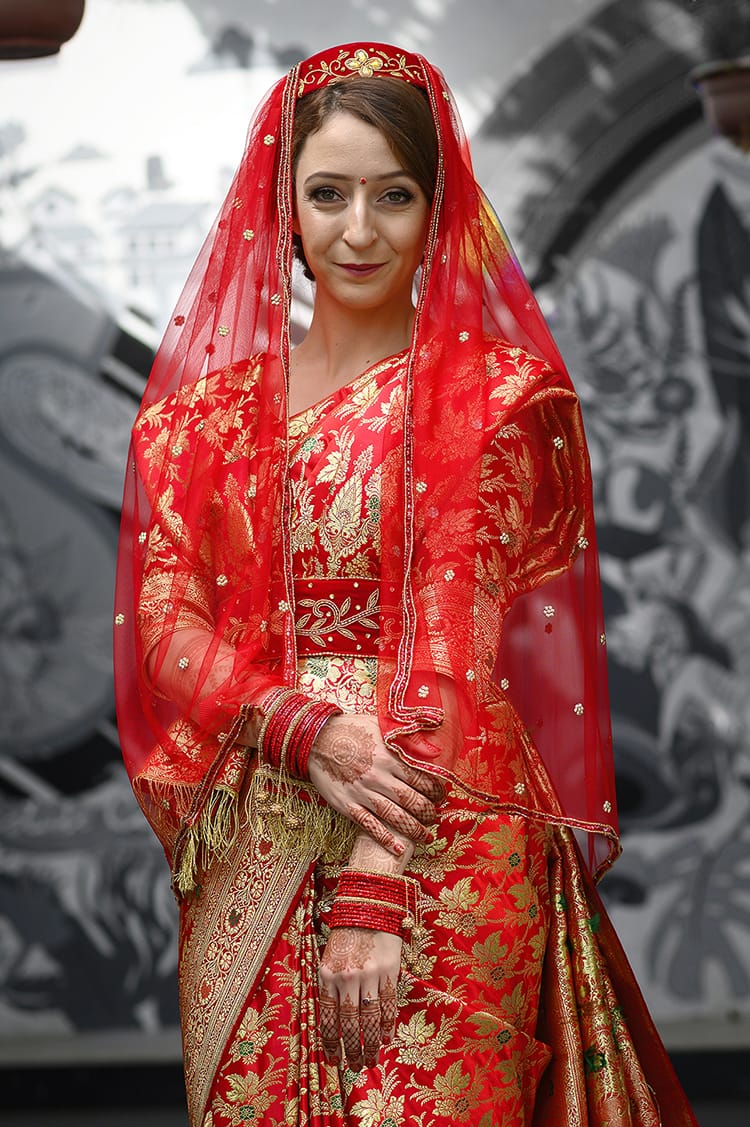
Mehendi
Mehendi is a tradition used in Hindu weddings in India. Due to its popularity in Bollywood films, it’s a tradition that has been adopted by Nepali brides in recent times. The day before the wedding, brides hold a Mehendi Party (like a bridal shower).
Traditionally, mehendi (henna) was applied as a medicine to relieve stress, keep the body from becoming tense, and cool the body. It was applied to the nerve endings on the hands and feet to be most effective. It’s also said that the smell of the mehendi acts as an aphrodisiac.
Now, mehendi is mostly decorative. It’s rumored that the darker the color, the more the groom loves you, and the longer it stays on, the happier your marriage will be. It’s also customary to hide the groom’s name somewhere in the pattern so he can’t find it. If the groom can’t find his name, he has to buy the bride a gift.
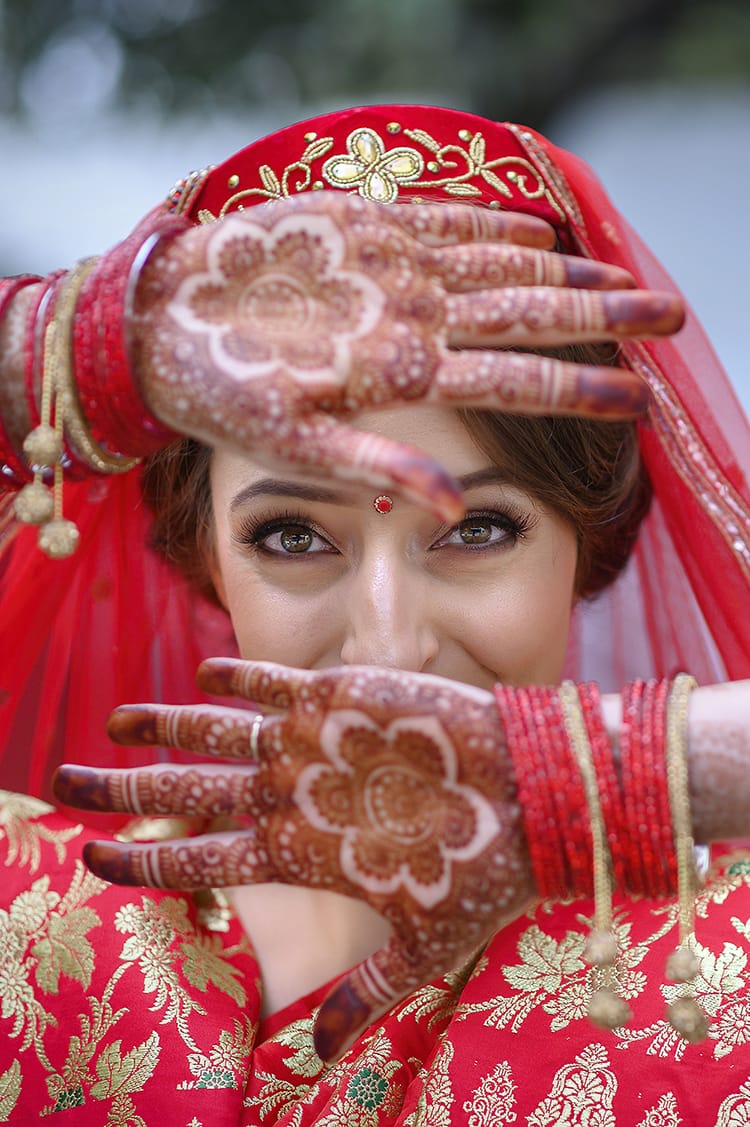
Kusha Ring
Family and friends asked if Suraj and I would be exchanging wedding rings during the ceremony. Yes, in Nepal it is very common to have wedding rings. What I found interesting was that at the beginning of the ceremony, we were given a grass ring to wear on our right fingers (before the exchanging of our wedding rings). This is called a “kusha ring.” The kusha grass is considered holy in Hinduism because it is long lasting. It’s believed that the ring makes you pure and doing any kind of worship without the ring on would be fruitless.
The grass used to make this ring only grows in certain tropical regions including some areas of Nepal. If used for worship, the grass cannot be picked any random day. It can only be picked the day after a full moon.
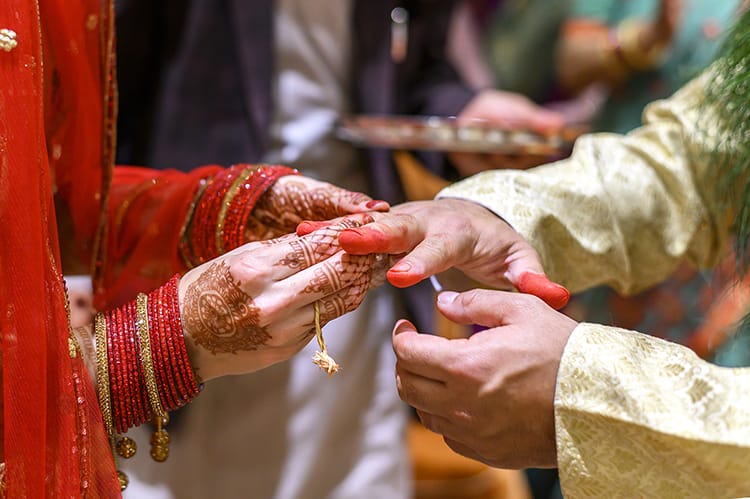
Kalash
During the pooja (worship), we had to give offerings to different elements of nature and gods. Each of the bowls on the table represents a different thing which we are praying to. The brass canister is kalash which is the most important one in the ceremony. The canister represents the cosmos, and it’s filled with water which represents the elixir of life. In a wedding ceremony it also represents fertility. The offerings made during pooja include fruit, money, water, flower petals, sindoor powder, and rice.
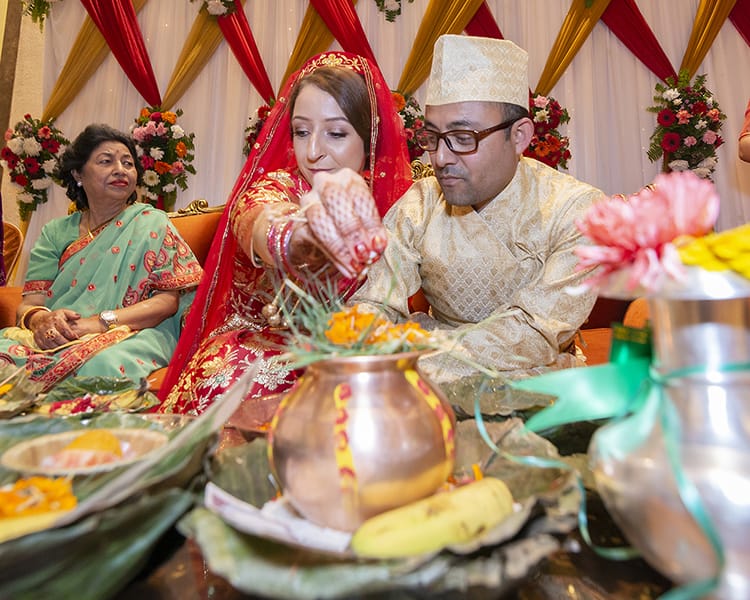
Diyo
The silver lantern is called diyo which holds oil and a cotton wick which is lit during the ceremony. This represents prosperity, purity, good luck and power. The light is believed to get rid of darkness and any evil spirits. Often a diyo is made out of clay. You can see them outside of temples and in people’s homes.
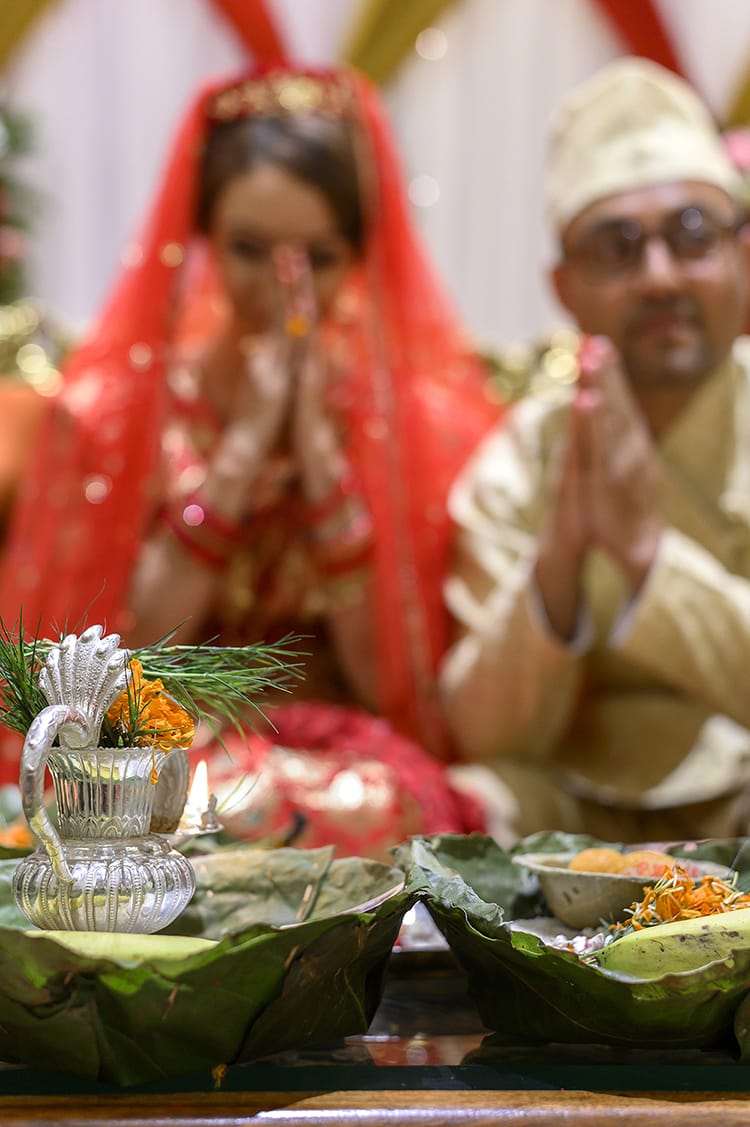
Circling of the Groom
The bride walks around the groom three times to represent that the groom is the center of her universe. When the bride finishes the circles, the walls around them fall and their souls are united. Depending on the ethnicity, some brides will throw flower petals or rice as they walk. I was to sprinkle water from a vase. In some cultures, you circle a fire seven times. So this can vary a little depending on the ceremony.
Bowing to the Groom
In traditional weddings, the bride bows down to the feet of the groom once she completes the circles. We opted not to do this as Suraj and I feel we are equals in our relationship. I bowed my head in respect but did not get down on my knees. This tradition is very controversial since women in Nepal want to be treated equally. Kissing someone’s feet in Nepal is the ultimate sign of respect which is often reserved only for one’s parents. It’s a really touching tradition, if you understand it fully. The problem people have with it at weddings is that the groom never kisses the bride’s feet in return.
Dubo Ko Mala
During Hindu weddings, it’s traditional that the bride and groom place a grass mala (garland) around each other’s necks. This is called a “Dubo Ko Mala.” The mala is made from Bermuda grass which does not fade or wilt after being picked from the ground. Because the grass stays so well preserved, it represents a long happy marriage full of good fortune.
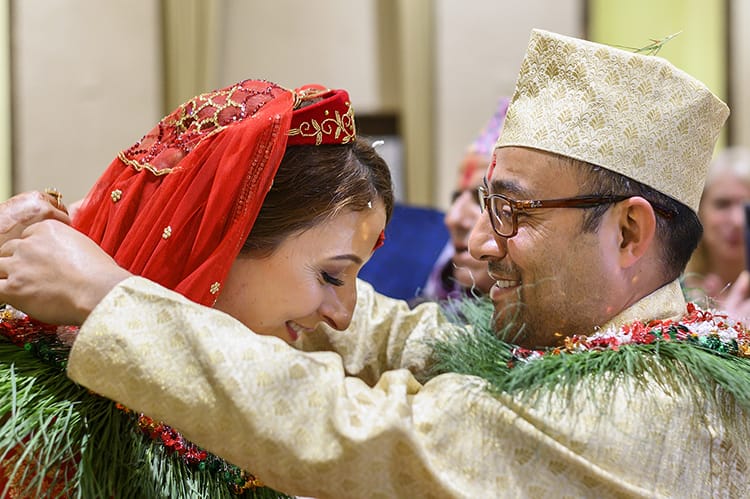
Sindoor Powder
Sindoor powder (the orange powder seen in the photo) is applied to a bride’s hair part by her husband when they get married. This is the sign that they are officially married (much like saying “I do” in western cultures). The powder can only be worn by married women and acts as a symbol like a wedding ring.
Traditional women continue to put the powder in their hair every day to show their everlasting love for their husbands. In modern times, most women wear the sindoor powder to special events and festivals rather than every day. Sindoor can be worn a few different ways. Some women make a small circle at the start of the hairline while others put it across the entire part.
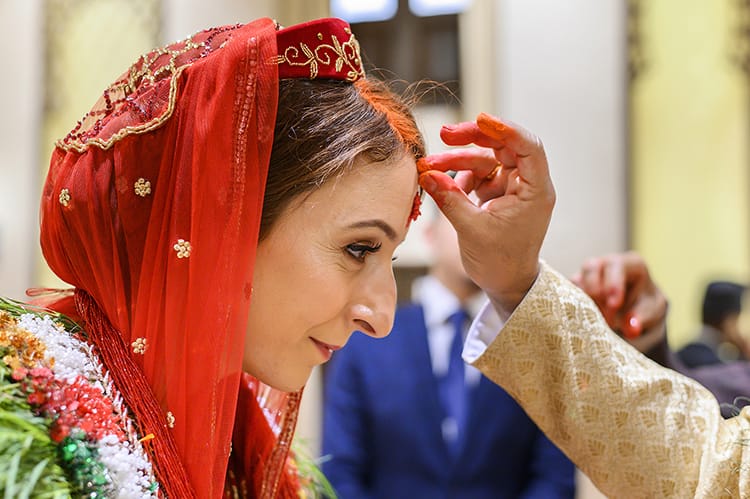
Tilhari
The red and gold necklace in this photo is a sign of marriage. The beads are called “pote” and the gold piece is called “tilhari.” The two items are bought separately and are then assembled together. My sister in law was kind enough to take me with her so that I could watch the necklace being made. If you find yourself in Ason Market, you can watch the necklaces being assembled on the sidewalk. It’s fascinating to watch.
A pote necklace is only worn by married women. The red and gold one in the photo is a special gift from the groom and his family on the wedding day. This necklace can be worn to special events like weddings and festivals while smaller beaded necklaces in different colors can be worn daily. The pote necklaces are like a wedding ring in Nepal. Traditional women won’t leave the house without having one on.
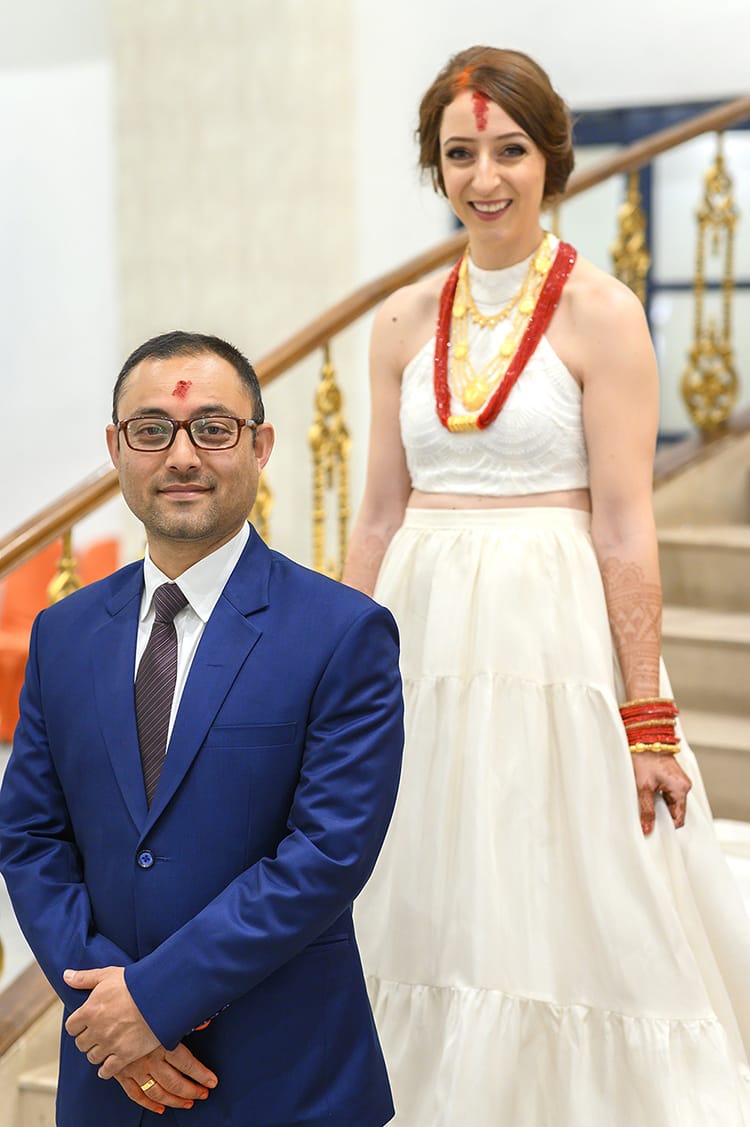
Supari
Supari is the name of a traditional ceremony in the Newari community where the bride is accepted into the groom’s family. During this ceremony, the bride hands 10 betel nuts to each member of the family starting with the oldest members down to the youngest members. Each member keeps 1 of the betel nuts and returns the rest. This symbolizes the brides’ acceptance into the family.
I’m told that in the past, betel nuts were given out in lieu of invitations to the wedding. This was back when everyone lived close to one another in tight knit communities. Betel nuts represent loyalty in love and a strong bond. It is also a symbol of fertility.
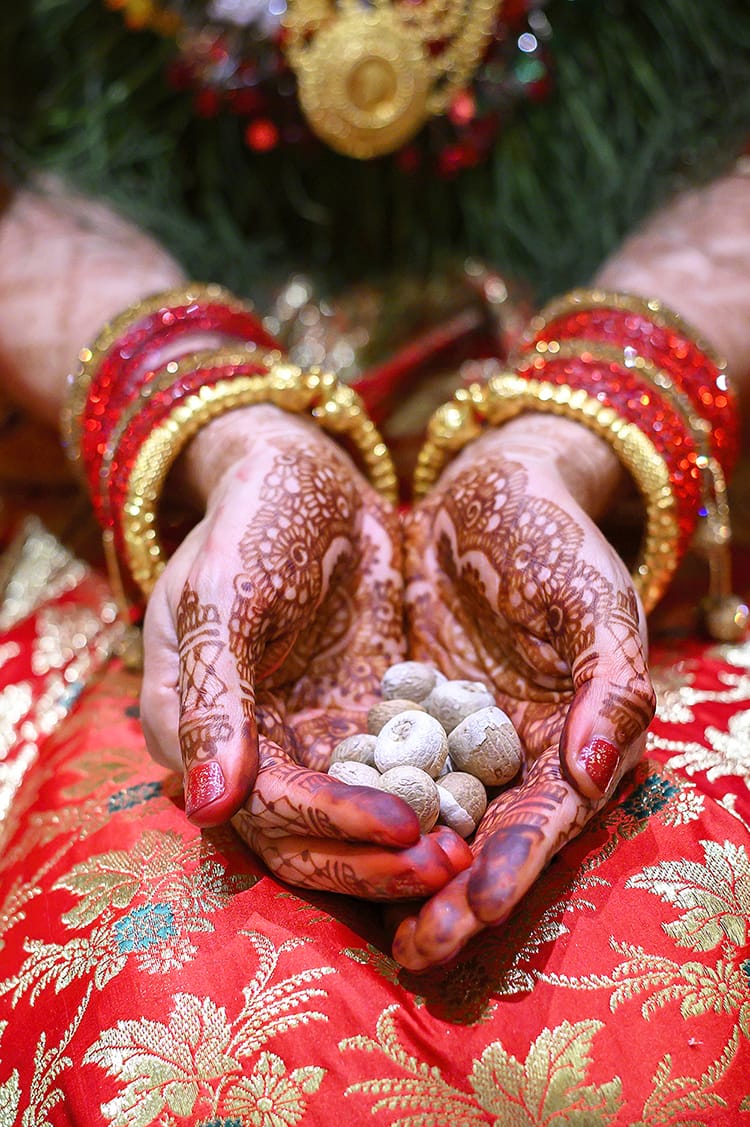
Bowing to Family
In the Newari caste, it’s expected that you bow down to your elder family members when greeting them. I always thought this was a form of respect (which it is), but it’s also so that your elders can give you a blessing. They hold their hands over your head and wish you good health and happiness.
Now that I’m officially part of the family, I’ll bow to the elders. Likewise, when a younger member of the family sees me, they will bow to me, and I will hold my hand up and give them a blessing.
The interesting part is that the older and younger members are determined by Suraj’s age (not my own). Since he’s 10 years older than me, I found myself awkwardly bobbling back and forth during the supari ceremony whenever someone appeared to be in between our age.
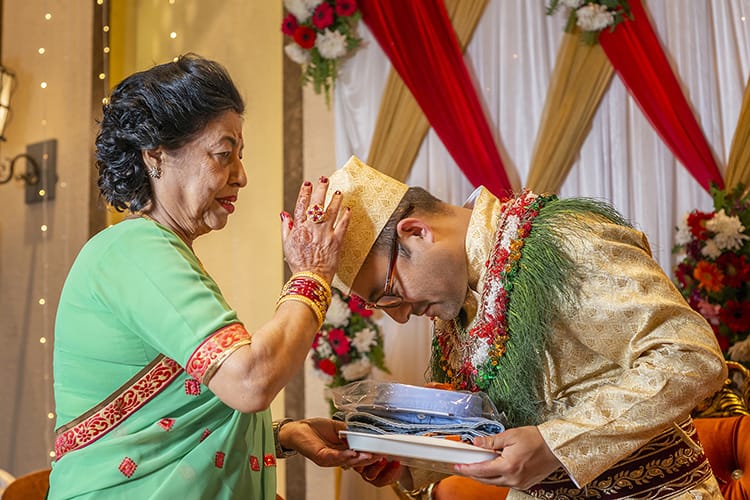
Nepali Wedding Receiving Line
After the wedding ceremony and introduction to the family is complete, friends begin to arrive. The bride, groom, and groom’s immediate family receive the guests in a receiving line. Guests often bring gifts, flowers, or khata.
In western weddings, the bride and groom walk around the wedding meeting guests as they go. In Nepal, you sit at the front and everyone comes to you. It’s typical to have between 500 and 1,000 guests at a Nepali wedding, so greeting everyone can take hours. If you are attending a wedding, this is when you present the happy couple with their wedding gift.
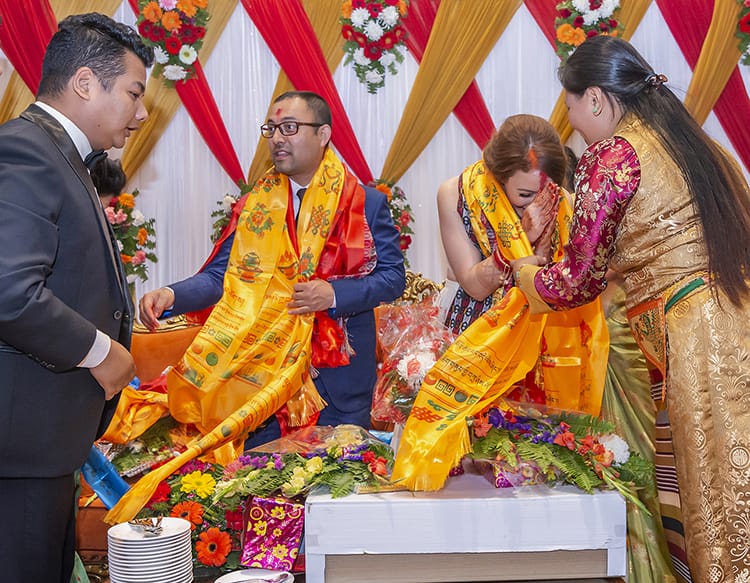
Khata
Khata originated in Buddhist cultures but are popular among all religions in Nepal. The scarf represents purity, good luck, compassion, and sincerity. It is often given as a gift of congratulations and also to guests when they arrive or depart. Many have mantras printed on the fabric that bring good luck to the wearer. Suraj and I were buried in khata, so I feel that our marriage has been blessed many many times.
Stealing the Grooms Shoes
During Nepali weddings, there is a tradition where the young women on the bride’s side steal the shoes of the groom. This was originally an Indian tradition, but now many Nepalese do it as well. During the ceremony, the groom removes his shoes and gives them to a female family member to protect. The bride’s sisters (or female relatives) have to try to steal them before the ceremony is over. Once the shoes have been stolen, they are held for ransom. Bargaining begins and the two sides settle on an acceptable amount of money. The bride’s side gets to take the money and have a nice night out. In arranged marriages, it’s a fun way for both sides of the family to get to know each other since it’s likely they have never met.
Lisi got a head start and tried to steal Suraj’s shoes before he even put them on (pictured). Sadly this didn’t count. During the ceremony, Suraj forgot to take his shoes off, so I made him sit down, stole the shoes and threw them at Lisi and Monet who happened to be nearby. Throughout the night, my friends hid the shoes from the kids on Suraj’s side who tried to steal them back. We gave them cryptic clues like “The American boy has them” which sent them screaming in Pat’s direction. Then, the Spanish woman, German man, blonde lady, so on and so on. We were finally called the victors and settled on $50 for the shoes. A steal for the groom! I’m told we could have gotten more but everyone was too drunk to negotiate…
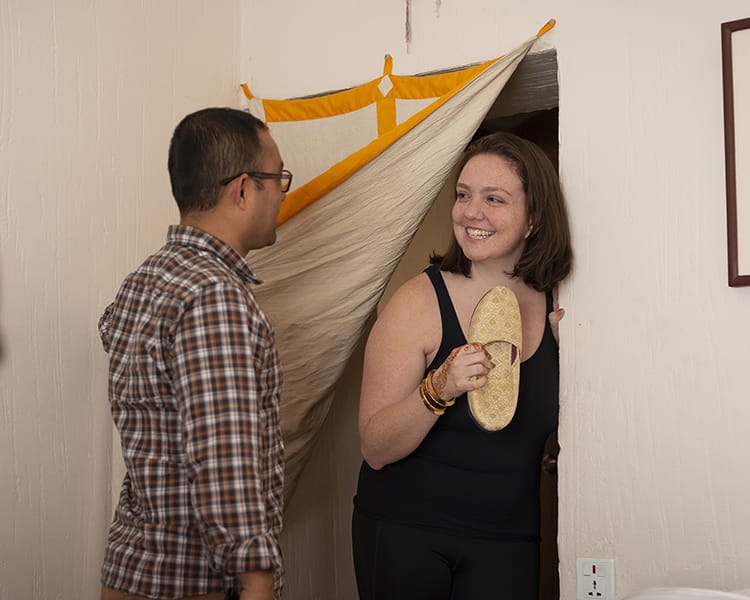
Vidaai
Vidaai is the part of the ceremony when the bride says goodbye to her family. In Nepal, most men and women live with their parents. When a couple gets married, the bride goes to live with the groom’s family. This is usually her first time leaving home for an extended period, therefore, the goodbyes are often very sad and full of tears. We skipped the vidaai ceremony because I haven’t really lived at home since I went to college. Not to mention, Suraj and I had already been living together for over 8 months (a very rare occurrence in Nepal). When we go to the States, we will stay with my mom at her house. Having some kind of epic goodbye during the wedding felt odd to me. Instead, me and my mom shared our tears at the airport when she flew back home.
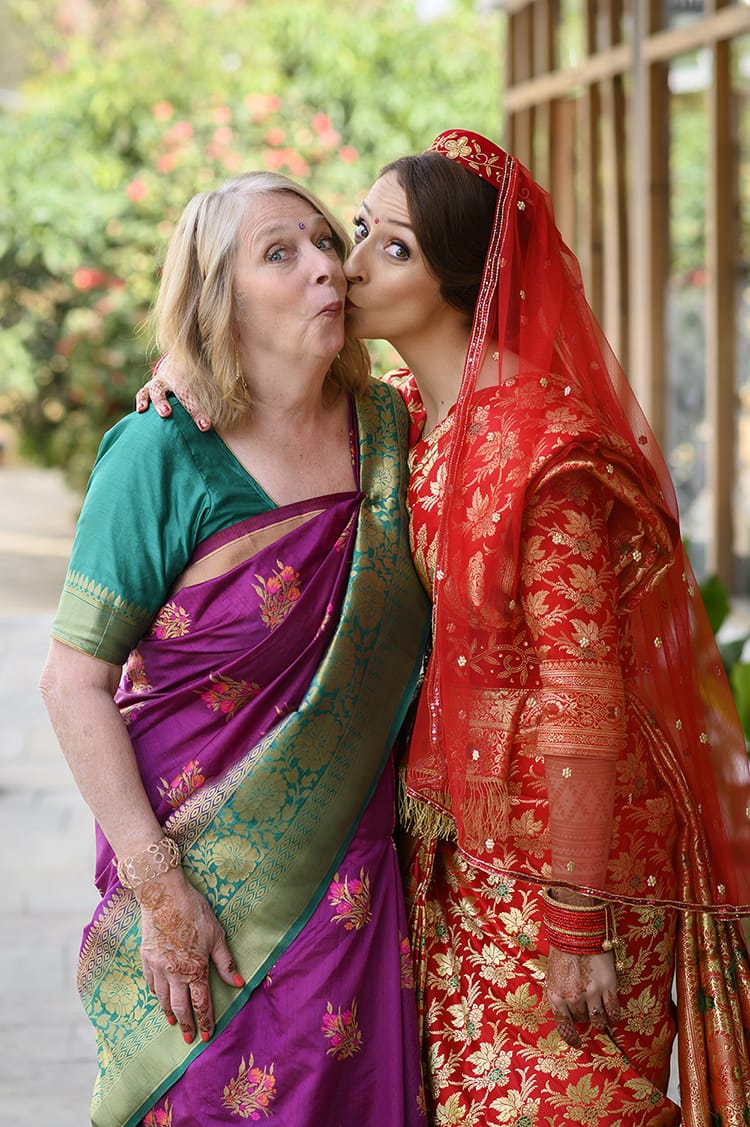
Janti
Typically, the wedding ceremony would be one day, and the reception is the following day. We did both of ours in a row at the same venue, so we didn’t have a janti. In most Nepali weddings, the groom’s family forms a parade like procession down the street as they arrive at the wedding (traditionally at the bride’s house). The procession includes the groom’s family and friends and a marching band/music. Everyone dances and celebrates as they walk to the bride’s home. Once the ceremony is complete, the janti takes the bride to the groom’s home for the first time.
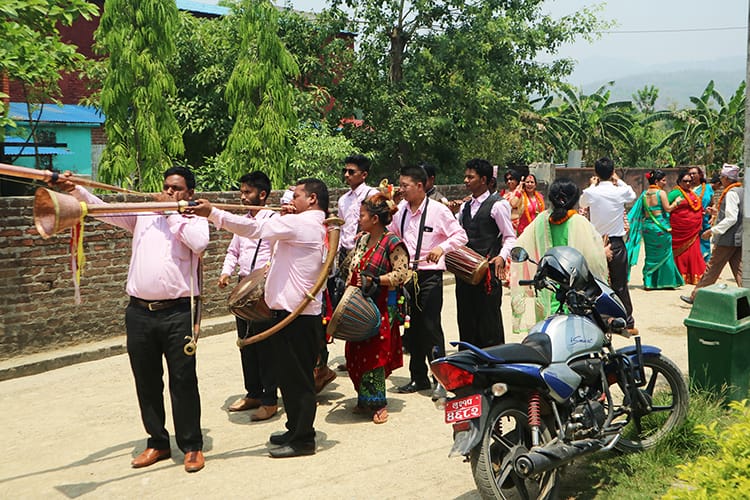
Ghar Bhitrauni Ceremony
In Nepal, it’s likely that the bride will then go to live with the groom and his parents. Therefore, there is a ceremony to welcome her to the home for the first time. Younger female members of the family will refuse to let the happy couple in and demand money from the bride to enter. This is a fun way for the young girls on the groom’s side to get some money to go out and celebrate.
Once the negotiations have been complete, the bride is allowed to enter. The older members of the family will welcome her in and bless the couple at the door.
Given how many different cultures there are in Nepal, I’m sure there are tons of things this article missed. But, if you’re an expat in Nepal and happen to be attending a Nepali wedding, this should help you understand the basics. The cool thing about Nepali weddings is that they are very informal in the sense that people talk and walk around during the ceremony. It’s not like a western wedding where everyone sits silently. So, if you have any questions, you can easily ask those around you to explain it to you!
Have any more questions about Nepali weddings? Ask in the comments!
You might also like…
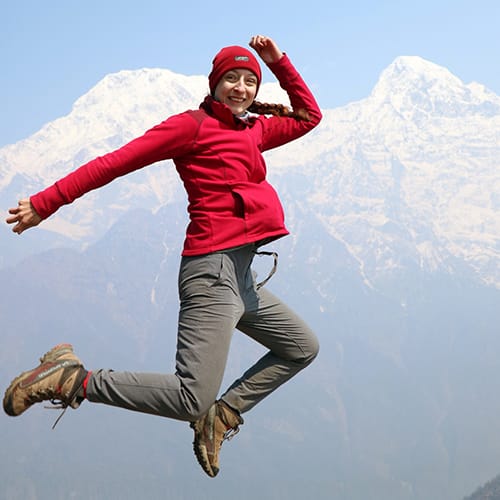
Michelle Della Giovanna
Writer at Full Time Explorer
I’m just your average New Yorker who quit her job in the fashion industry to explore the world. Come find out what it’s like to trade in five-inch heels for squat toilets.
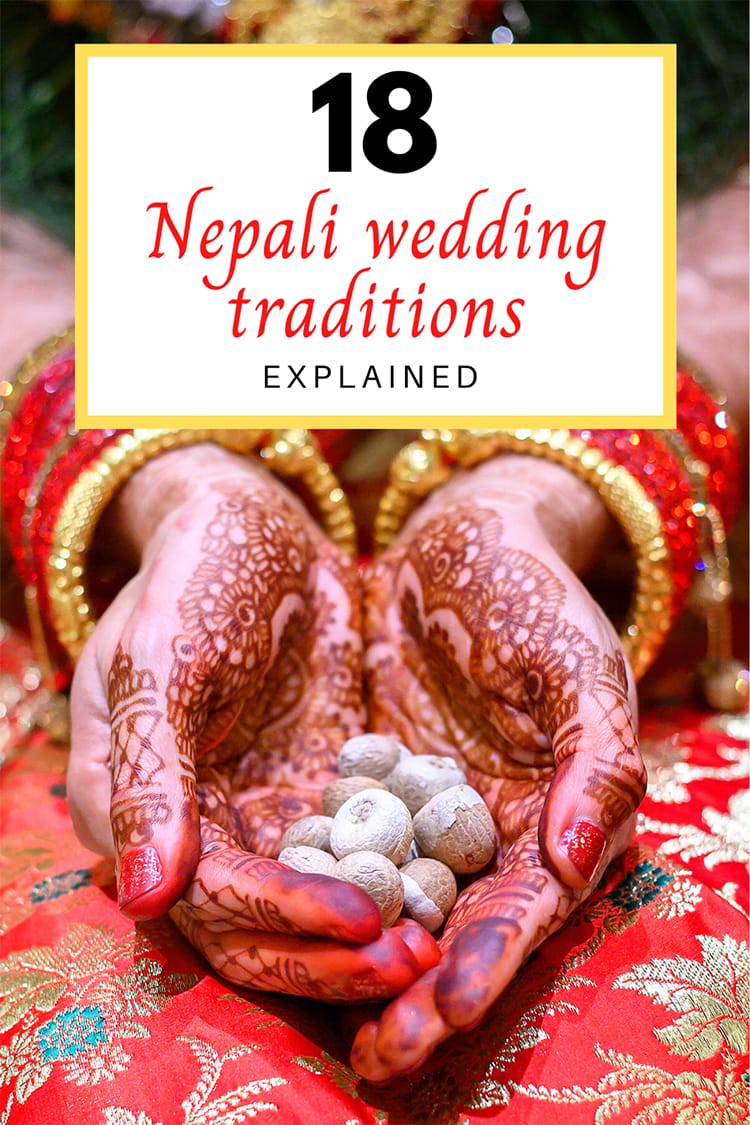
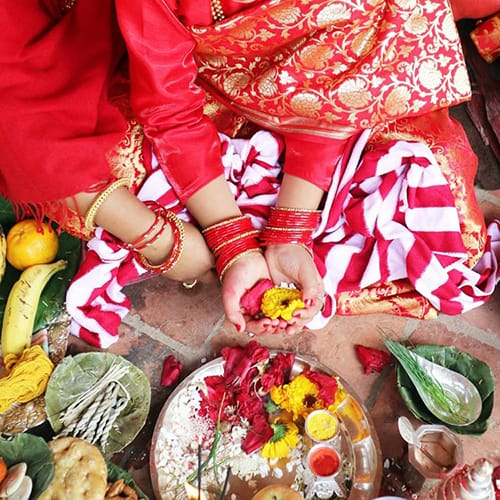
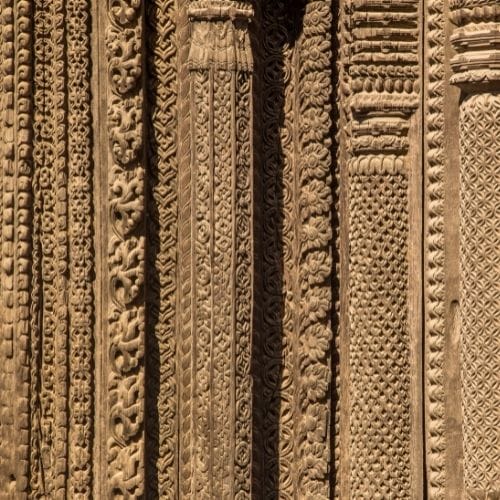
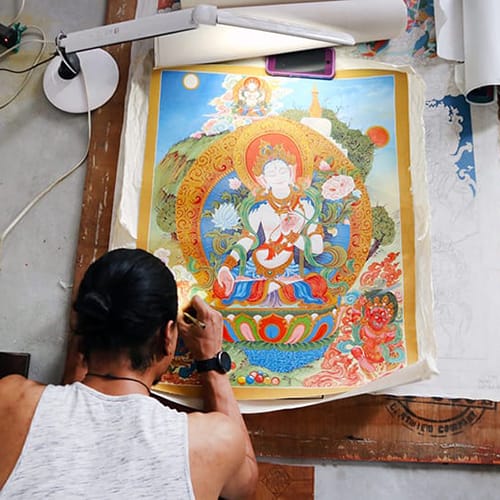
This is the best Article ever get a chance to read related to Nepalese Wedding Traditions. You explained every important part of the wedding ceremony which makes this blog the best one.
Thank you so much for your kind words!
Congratulations on your wedding! This was beautiful article.
Also I don’t know about Newari culture but in Brahmin/Chettri even the groom touches bride’s feet after she touches his. Wanted to share that, you are right about equality thing ❤
Thank you so much! I’m happy to hear that the bride and groom touch each other’s feet in some ceremonies <3
Very helpful as I will have my own Hindu wedding as you did. We’ve been debating which ceremonies we will do and won’t do because I’m American as well. Thank you for your insight sister!
Congrats on your wedding! And, I’m so happy you found the article helpful. Feel free to reach out if you have any questions. I know I had a million questions before our wedding haha. Enjoy your big day <3
Thank you so much for the article! My boyfriend (Nepali) and I (swiss&german) will marry soon (after covid). It’s very useful to me to understand better our parts during the ceremony.
Having been once at a nepalese wedding ceremony and understood nothing, I appreciate the knowledge !
Congrats on your upcoming wedding Chloe! I’m so happy you found the article useful and I wish you all the best <3
I loved reading your article! It was hard for me to understand and remember all that happened at my wedding, and this brought back many memories!
I’m so happy this brought back all the memories! There is a lot going on during the wedding and it’s hard to process it all. Even I like to look back at this blog to remember everything haha.
My son is engaged to a Nepali woman of Newari ethnicity. They met here in the United States, where she has been studying, will marry here first and then marry again in Nepal. I was happy to find this, as I will be unable to go to Nepal for the wedding.
Hi Martha! Congrats to your son and his fiancé! I’m so happy this post was able to help. We had a lot of family who couldn’t make it to our wedding, so we did a Facebook Live of the ceremony and everyone really enjoyed being able to watch it from the States (although the time difference was a little crazy haha)
You must go, for happiness of soul.
Such a beautiful blog from an American bride. So much in detail and explained so well. I vould actually live the moment.
Thank you so much!
Hi, Nice explanation. I have only been to Nepali weddings in the US and sometimes they are modified here. I have two Nepal friends getting married today and they sent pictures of some of the women shifting a white sand for some reason. They said it was a ritual but did not know what for. Have you heard of it? Do you know the significance ? Sorry I do not have a picture it was on Snapchat and they disappear.
Do you by any chance know what caste or ethnic group they are from? A lot of the rituals depend on that. My husband and I haven’t heard of this, but I could always ask a friend from the same ethnicity.
This is such a cute little well explained summary. You have embraced our culture with so much love and warmth.
Thank you so much! That means a lot to me! ❤️
Hi Michelle,
Congratulations on your wedding! Gorgeous photos and loved the article. I am British-Nepalese and have attended a few weddings and wedding parties in Nepal but never really understood what was what and at what point the couple were actually married. When I asked my parents, they didn’t really have much to say- pretty sure they didn’t know themselves! The way you’ve explained it is so helpful.
I’m getting married next month (in the UK) and possibly having some sort of small ceremony in Nepal in a few months. Really glad to have found this so I can understand it better and share what Nepali/Newa wedding is like with my fiance!
I’m so happy you found this article helpful and congrats on your engagement and wedding!!
It might look like an Indian wedding style, but the Nepalese wedding style is different from the Indian style. We do have our traditions and wedding process. Anyway, thank you for the information. I am happy to hear you spent half a year in Nepal.
When I wrote the original blog post I hadn’t mentioned India and many Nepali people corrected me and told me some of the traditions originated in India. I thought they were all Nepali traditions. I updated the post after several people corrected me. Those traditions have taken their own form here but were inspired by Indian culture. Also, I live in Nepal and have spent 5 years here ?
Their wedding looks so fun.
Thank you Michelle for your beautiful words and insightful experiences from your wedding celebration.
I am a wedding celebrant, and have an upcoming marriage ceremony where the couple are Nepalese (bride) and Irish (groom). Although I have helped with other cultural rituals and traditions, this will be my first Nepali mix. I am looking forward to including the Diyo, Mala, Sindoor, Tilahri and I believe that she’s including the feet blessing.. So your blog was absolutely fabulous to give me an idea of how elements are included and performed. THANK YOU!
I’m so happy this helped! <3
Wow I’m so grateful I found this article and read all the comments as well. I am a Canadian marrying a Nepali from the Newar caste next month. There is just so much I don’t know and having some basic understanding and hearing everyone share they’re own experiences means a lot. His family has been taking care of everything because I don’t know anything and I was wondering if you could tell me if there is anything specifically the brides family would normally contribute? My parents are coming for the ceremony and they are keen to contribute and participate and are just not sure how.
Thanks again
Hey Beth!
Congrats on your upcoming wedding! My husbands family also organized everything as I had no idea what was going on, however I did take charge of organizing a mehendi party. That’s like the Nepali version of a bridal shower. While they used to be just for women in the family, now men are sometimes invited as well. I found this to be a nice way for me to contribute to the wedding festivities and host one of the events. I held the event at a restaurant, hired mehendi artists I found on instagram, and invited the women closest to my husband as well as my female friends. It was a lot of fun!
Hope this helps!
Best,
Michelle
My cousin is hosting a hindu wedding soon and she said that i will be by her side the entire time making sure everything is alright (her hair, makeup, clothes). Kind of like the maid of honor since she said i will be the only one , is there a specific label to this in nepali culture?
Hello, I don’t think there is a specific name for this in Nepal. Normally a sister, close relative, or friend stays with the bride the entire time to help her during the ceremony. When I’ve gone to weddings, I’ve heard Nepali brides call it a Maid of Honor or Bridesmaid because I don’t think there is a Nepali word for it.
wow super cool, it looks so great, pictures are the best and thank you for the description about Nepali marriage ceremony, I enjoyed lots by reading this article.
Thank you!
greatly explained.
Thank you
We are attending our grandson’s wedding here in the U. S. this December. He is an American and his fiancé’s family is from Nepali. They are having the same type of wedding you had.
My question is, what is the traditional wedding gift the grandparents give to the bride and groom ?
Hello! Congrats to your grandson and his fiance! In Nepal, typically the groom’s family give the bride some kind of gold jewelry or fancy sarees to welcome her into the family. This isn’t always the case and it may depend on their traditions and ethnicity. But for many Hindus in Nepal, they give gold jewelry or a saree.
Thank you for this lovely article and especially this answer! We are British and my son is marrying a lovely Nepalese girl in England in the summer. At the wedding there will be a Nepali celebration followed by the British ceremony. I so want to get my part ‘right’ and also would like to do my best to make sure the bride’s parents feel happy and welcome. I am also a little concerned about what we should give them as I believe it is commonplace for the parents to exchange gifts. Any advice would be very welcome!
Hello Jackie,
Congrats on your sons engagement. It sounds like it will be a lovely wedding! A lot of the ceremony will depend on the caste she belongs to as each caste has a different ceremony and traditions. Typically, the grooms parents would gift the bride with gold and sarees as mentioned in my comment. Exchanging gifts between the parents also depends a bit on caste, but most people are happy with clothing as a gift. In Nepal, usually people will gift fabric (a saree for women or suit fabric for men) and then the person will go to the tailor and have it made in their own size. When I got married, I gifted everyone western clothing and they were happy, but it was a little more difficult as I needed to know their sizes. Feel free to reach out if you have any other questions.
Hello Jackie, may i please ask how your son’s fiancee came to Britain? I’m not being nosy but trying to find out if it is possible to bring my (hopefully future husband!) here. It is not easy to navigate official rules etc. Thank you! And all the best for their wedding.
I thank you very much and congratulate you for being our BHAUJYU. I was glad to read this amazing article about Nepali cultural wedding information you have shared through a great site.
Cheers!
Thank you so much!
Hello Michael! Thank you very much for sharing. I am currently conducting research on weddings in Nepal. Do you have any relevant videos in your article? I think your content is very good, and I hope you can better understand it through the video.
Hello, Thanks for your kind words! Unfortunately, I don’t have any video of the wedding.
Best,
Michelle
Thanks for informative blog
Great article.
Can I ask about the paperwork etc? How it is actually arranged? Do you now live in Nepal, do you get citizenship there and/or is your husband able to live and work in the UK? I would love a Nepali wedding but is not easy trying to find out rules for him living in Uk after?
Thank you!
In Vidaii certain articles are traditionally given to the bride these are; Kasturi (Musk),
Bhalu titti (Bears gall bladder ) and other articles . Do you know if you please let other articles be listed? I am searching for these. Thank you very much
I don’t know the other articles given but I will ask at the next wedding I attend. It may depend on the caste, region, or traditions of that family. It may be best to ask your local priest.
“Love your writing style! So engaging.”
Thank you for sharing well Article. It will highly support for Nepal Tourism as well.
We have similar wedding traditions in Istanbul Turkey
This blog from an American bride is absolutely beautiful. It’s filled with such rich detail and thoughtful explanations that I could truly feel like I was living the moment.
Thank you so much for your kind words.
Great information ,thank you so much for sharing ….
Such a beautiful article that I had to leave a comment here. Love your work!
Thank you so much!
Hi there,
Well written, but hardly researched and full of factual errors. More than half of the article is based on what one of the janti told you, apparently, and they were not well-informed about the symbolisms and their representations. I wish you had done some research before posting this. Good luck.
Hello,
I did a lot of research for this blog, but I’d love to know what you feel is inaccurate so that I can improve it.
Great explanation about Nepal culture. I really like your blog. It improves my knowledge about lifestyle. The culture awareness improves information about life growth.
Really enjoyed reading about the rich and colorful wedding traditions of Nepal—it’s amazing how each ritual has its own deep meaning. I especially loved learning about the unique customs and attire. Have you ever attended a Nepali wedding yourself? Thanks for sharing such a vibrant glimpse into the culture!